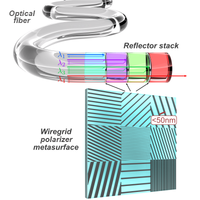当前位置:
X-MOL 学术
›
Phys. Rev. X
›
论文详情
Our official English website, www.x-mol.net, welcomes your
feedback! (Note: you will need to create a separate account there.)
Characterizing Optical Fiber Transmission Matrices Using Metasurface Reflector Stacks for Lensless Imaging without Distal Access
Physical Review X ( IF 11.6 ) Pub Date : 2019-12-09 , DOI: 10.1103/physrevx.9.041050 George S. D. Gordon , Milana Gataric , Alberto Gil C. P. Ramos , Ralf Mouthaan , Calum Williams , Jonghee Yoon , Timothy D. Wilkinson , Sarah E. Bohndiek
Physical Review X ( IF 11.6 ) Pub Date : 2019-12-09 , DOI: 10.1103/physrevx.9.041050 George S. D. Gordon , Milana Gataric , Alberto Gil C. P. Ramos , Ralf Mouthaan , Calum Williams , Jonghee Yoon , Timothy D. Wilkinson , Sarah E. Bohndiek

|
The ability to retrieve image data through hair-thin optical fibers promises to open up new applications in a range of fields, from biomedical imaging to industrial inspection. Unfortunately, small changes in mechanical deformation and temperature can completely scramble optical information, distorting any resulting images. Correction of these dynamic changes requires measurement of the fiber transmission matrix (TM) in situ immediately before imaging, which typically requires access to both the proximal and distal facets of the fiber simultaneously. As a result, TM calibration is not feasible during most realistic usage scenarios without compromising the thin form factor with bulky distal optics. Here, we introduce a new approach to determine the TM of multimode or multicore optical fibers in a reflection-mode configuration, without requiring access to the distal facet. We propose introducing a thin stack of structured metasurface reflectors at the distal facet of the fiber, to introduce wavelength-dependent, spatially heterogeneous reflectance profiles. We derive a first-order fiber model that compensates these wavelength-dependent changes in the fiber TM and show that, consequently, the reflected data at three wavelengths can be used to unambiguously reconstruct the full TM by an iterative optimization algorithm. Unlike previous approaches, our method does not require the fiber matrix to be unitary, making it applicable to physically realistic fiber systems that have non-negligible power loss. We demonstrate TM reconstruction and imaging first using simulated nonunitary fibers and noisy reflection matrices, then using larger experimentally measured TMs of a densely packed multicore fiber (MCF), and finally using experimentally measured multiwavelength TMs recorded from a step-index multimode fiber (MMF). Parallelization of multiwavelength in situ measurements could enable experimental characterization times comparable with state-of-the-art transmission-mode fiber TM experiments. Our findings pave the way for online TM calibration in situ in hair-thin optical fibers.
中文翻译:

使用超表面反射器叠堆对光纤传输矩阵进行表征,实现无透镜成像而无需远距离访问
通过纤细的光纤检索图像数据的能力有望在从生物医学成像到工业检查的各个领域开拓新的应用。不幸的是,机械变形和温度的微小变化会完全扰乱光学信息,从而扭曲所有生成的图像。纠正这些动态变化需要现场测量光纤传输矩阵(TM)紧接在成像之前,这通常需要同时访问光纤的近端和远端。结果,在大多数现实使用情况下,如果不使用笨拙的远端光学器件来牺牲薄型尺寸,TM校准是不可行的。在这里,我们引入一种新方法来确定反射模式配置中的多模或多芯光纤的TM,而无需访问远侧小平面。我们建议在光纤的远端刻面引入一薄层结构化的超表面反射器,以引入与波长有关的空间异质反射率曲线。我们推导了一阶光纤模型,该模型补偿了光纤TM中这些与波长相关的变化,并表明,通过迭代优化算法,可以使用三个波长的反射数据来明确地重建完整的TM。与以前的方法不同,我们的方法不需要光纤矩阵是单一的,因此适用于功率损耗不可忽略的物理逼真的光纤系统。我们演示了TM重建和成像,首先使用模拟的非单一光纤和嘈杂的反射矩阵,然后使用密集封装的多芯光纤(MCF)的较大的实验测量的TM,最后使用从阶跃折射率多模光纤(MMF)记录的实验测量的多波长TM 。多波长并行化 使其适用于功率损耗不可忽略的物理现实光纤系统。我们演示了TM重建和成像,首先使用模拟的非单一光纤和嘈杂的反射矩阵,然后使用密集封装的多芯光纤(MCF)的较大的实验测量的TM,最后使用从阶跃折射率多模光纤(MMF)记录的实验测量的多波长TM 。多波长并行化 使其适用于功率损耗不可忽略的物理现实光纤系统。我们演示了TM重建和成像,首先使用模拟的非单一光纤和嘈杂的反射矩阵,然后使用密集封装的多芯光纤(MCF)的较大的实验测量的TM,最后使用从阶跃折射率多模光纤(MMF)记录的实验测量的多波长TM 。多波长并行化原位测量可以使实验表征时间与最新的传输模式光纤TM实验相当。我们的发现为毛发稀疏的光纤在线原位TM校准铺平了道路。
更新日期:2019-12-11
中文翻译:

使用超表面反射器叠堆对光纤传输矩阵进行表征,实现无透镜成像而无需远距离访问
通过纤细的光纤检索图像数据的能力有望在从生物医学成像到工业检查的各个领域开拓新的应用。不幸的是,机械变形和温度的微小变化会完全扰乱光学信息,从而扭曲所有生成的图像。纠正这些动态变化需要现场测量光纤传输矩阵(TM)紧接在成像之前,这通常需要同时访问光纤的近端和远端。结果,在大多数现实使用情况下,如果不使用笨拙的远端光学器件来牺牲薄型尺寸,TM校准是不可行的。在这里,我们引入一种新方法来确定反射模式配置中的多模或多芯光纤的TM,而无需访问远侧小平面。我们建议在光纤的远端刻面引入一薄层结构化的超表面反射器,以引入与波长有关的空间异质反射率曲线。我们推导了一阶光纤模型,该模型补偿了光纤TM中这些与波长相关的变化,并表明,通过迭代优化算法,可以使用三个波长的反射数据来明确地重建完整的TM。与以前的方法不同,我们的方法不需要光纤矩阵是单一的,因此适用于功率损耗不可忽略的物理逼真的光纤系统。我们演示了TM重建和成像,首先使用模拟的非单一光纤和嘈杂的反射矩阵,然后使用密集封装的多芯光纤(MCF)的较大的实验测量的TM,最后使用从阶跃折射率多模光纤(MMF)记录的实验测量的多波长TM 。多波长并行化 使其适用于功率损耗不可忽略的物理现实光纤系统。我们演示了TM重建和成像,首先使用模拟的非单一光纤和嘈杂的反射矩阵,然后使用密集封装的多芯光纤(MCF)的较大的实验测量的TM,最后使用从阶跃折射率多模光纤(MMF)记录的实验测量的多波长TM 。多波长并行化 使其适用于功率损耗不可忽略的物理现实光纤系统。我们演示了TM重建和成像,首先使用模拟的非单一光纤和嘈杂的反射矩阵,然后使用密集封装的多芯光纤(MCF)的较大的实验测量的TM,最后使用从阶跃折射率多模光纤(MMF)记录的实验测量的多波长TM 。多波长并行化原位测量可以使实验表征时间与最新的传输模式光纤TM实验相当。我们的发现为毛发稀疏的光纤在线原位TM校准铺平了道路。











































 京公网安备 11010802027423号
京公网安备 11010802027423号